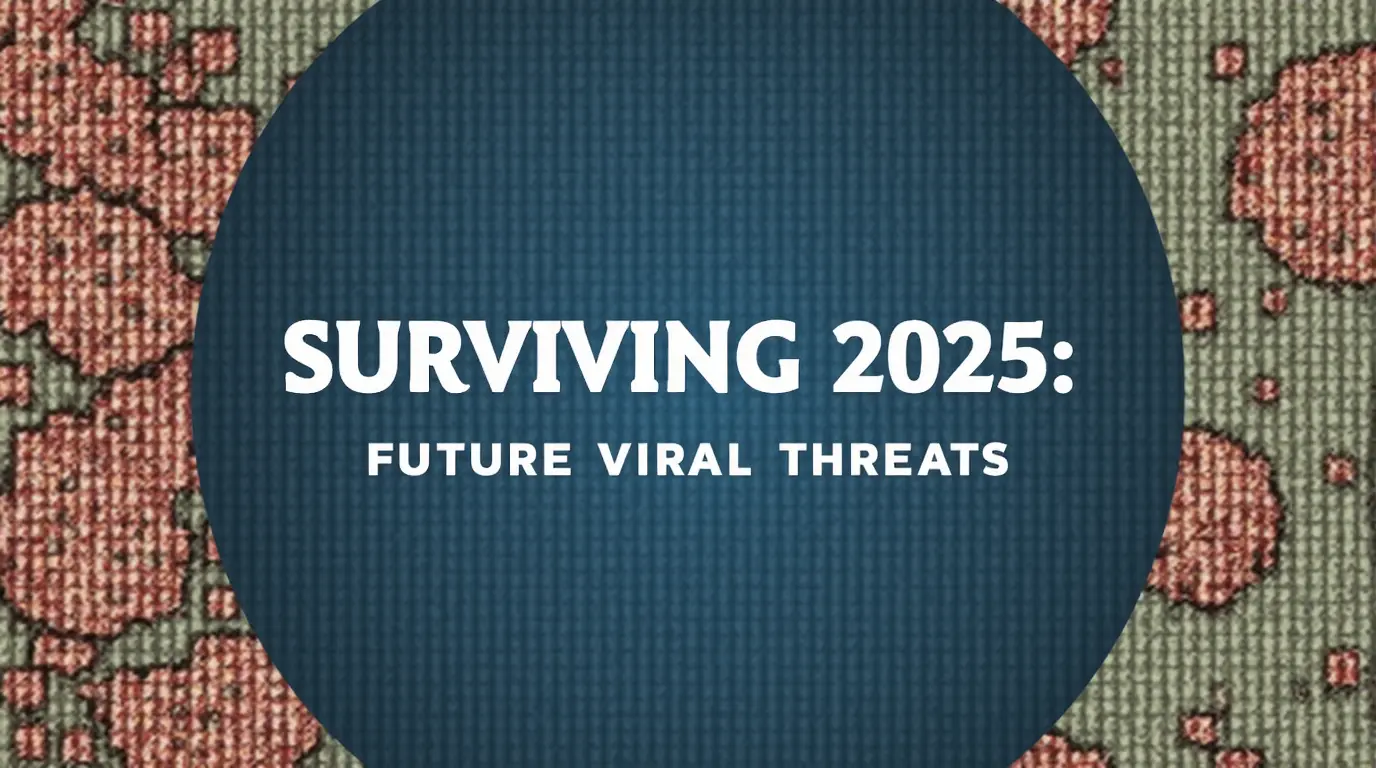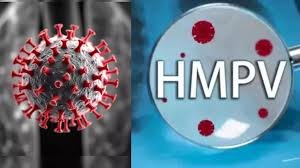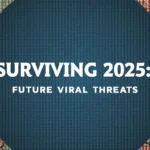We envision a world where everyone has the tools and knowledge to live a balanced, healthy, and fulfilling life. By providing reliable resources, personalized programs, and community support, we aim to be a beacon of hope for those on their health journey.
Table of Contents
Understanding Viral Threats: Surviving 2025
The landscape of viral threats has undergone significant changes over the past few decades, shaped by various pandemics and outbreaks that have had lasting effects on global health. Historical data reveals a pattern where the emergence of viral threats often correlates with increased human-animal interactions, urbanization, and changes in environmental conditions. Notable pandemics, such as the 1918 influenza pandemic, exemplify how quickly viruses can propagate, emphasizing the importance of preparedness in health systems worldwide.
Throughout the late 20th century and into the early 21st century, the world has witnessed several viral outbreaks that have raised alarms. The emergence of HIV/AIDS in the late 1970s and early 1980s marked a pivotal moment, as it challenged existing health norms and implemented a paradigm shift in public health responses. Similarly, the outbreak of SARS in 2003 showcased the potential for viruses to leap from animals to humans, resulting in widespread fear, economic disruption, and significant investment in research. Instances like the H1N1 influenza outbreak in 2009 and the Ebola crisis of 2014 further demonstrated the capacity for viral threats to escalate rapidly, necessitating an agile and coordinated global health response.
The 2020 COVID-19 pandemic has since become a critical reference point, revealing vulnerabilities in public health infrastructure globally. This crisis highlighted the mutation rates of viruses, with SARS-CoV-2 exhibiting a remarkable ability to adapt, leading to diverse strains that posed new challenges to containment efforts. Current analyses of such historical threats underscore the need for robust surveillance systems and innovative solutions that can swiftly adapt to the changing behavior of viruses. By studying past viral outbreaks, we can glean insights into the triggers behind their emergence, understand their impacts on health systems, and develop strategic frameworks to better prepare for future threats.
Emerging Viruses: Identifying Potential Threats for 2025
The landscape of infectious diseases is continually evolving, and emerging viruses pose significant health risks. As we look toward 2025, it is crucial to identify potential viral threats that could impact global public health. Scientists utilize various criteria to predict emerging viruses, which include monitoring zoonotic diseases, analyzing genetic mutations, and assessing environmental changes. Don’t forget infection The Human Metapneumovirus (HMPV) is a pathogen that was first identified in 2001 by a team of researchers led by Dr. J. S. van den Hoogen which appeared recently. These predictive measures are critical in preparing strategies to mitigate risks associated with new viral strains.
A notable example of an emerging virus is the Nipah virus, which has been associated with significant outbreaks in several regions. This virus is transmitted from animals to humans and can cause severe respiratory illness and neurological symptoms. Another virus to monitor is the Zika virus, previously linked to birth defects during an outbreak. Ongoing studies indicate that Zika may resurface under changing environmental conditions, given its strong association with increased temperatures and urbanization.
Indeed, various factors contribute to the emergence of viruses. Climate change has a substantial impact, as it alters habitats and migratory patterns, potentially increasing human-wildlife interactions. Urbanization also plays a role, facilitating close contact between humans and vectors such as mosquitoes, which can lead to increased transmission rates. Additionally, global travel amplifies the risk of virus spread beyond local outbreaks, creating a mosaic of interconnected health challenges.
Furthermore, enhanced surveillance systems can facilitate the early detection of emerging viral threats. Monitoring viral genetic changes allows scientists to assess which strains have the potential to cause outbreaks. By remaining vigilant and fostering international collaboration, public health entities can mitigate the risks posed by new viruses. Thus, equipping communities and health officials with knowledge about viral strains to watch for helps fortify defenses against future pandemics.
Surveillance and Monitoring: The First Line of Defense
In an era marked by rapid technological advancements and increasing connectivity, viral surveillance systems have emerged as a crucial first line of defense against viral threats. These systems enable the identification and tracking of viruses, thereby facilitating timely responses that can mitigate the impact of outbreaks. By leveraging current technologies and methodologies, health organizations can enhance their monitoring capabilities, making it possible to detect viral activity in real-time.
One of the most significant advancements in viral surveillance is genomic sequencing. This technology allows scientists to analyze the genetic material of viruses, revealing their potential mutations and spread patterns. By comparing sequences from infected individuals, researchers can trace the origins of outbreaks and predict future trends. Genomic data combined with robust data analytics can identify hotspots of viral activity, enabling targeted interventions to control spread.
Additionally, integrating artificial intelligence and machine learning into surveillance systems has revolutionized how health agencies monitor viral threats. These technologies can analyze vast datasets, identifying patterns and anomalies that may indicate emerging viral outbreaks. Predictive models generated through such analyses play a critical role in informing public health decisions and resource allocation, enhancing preparedness for potential crises.
Moreover, the importance of international cooperation and information sharing cannot be overstated. Countries and organizations must collaborate to create a unified approach to viral monitoring. The establishment of global databases for sharing genomic and epidemiological data enhances collective detection efforts. Initiatives like the Global Health Security Agenda exemplify the concerted efforts to fortify surveillance systems worldwide, ensuring that all nations are equipped to handle viral threats effectively.
Ultimately, a multifaceted approach that combines advanced technologies, data analytics, and international collaboration is essential to build robust surveillance systems capable of responding to the viral threats of 2025 and beyond.
Vaccination Strategies: Preparing for Future Outbreaks
The emergence of viral threats necessitates robust vaccination strategies that can adapt to rapidly changing circumstances. Advances in vaccine technology have been pivotal in this regard, notably the development of mRNA vaccines and viral vector vaccines. These cutting-edge technologies enable quicker responses to outbreaks by facilitating rapid vaccine design and production. For instance, mRNA vaccines have demonstrated exceptional efficacy in providing immunity and can be adapted swiftly to target new viral strains, thereby reinforcing the importance of flexibility in vaccination strategies.
In addition to technological advancements, the role of public health campaigns cannot be understated. Effective communication strategies can enhance public understanding and acceptance of vaccination, which is crucial for achieving herd immunity. Campaigns must focus on educating the population about the benefits of vaccines, dispelling myths, and addressing the concerns surrounding vaccine safety. By engaging with communities and utilizing various media platforms, health authorities can create a positive narrative around vaccination, encouraging widespread participation in immunization programs.
Developing robust vaccination programs requires comprehensive planning and collaboration across different sectors. Governments must prioritize funding and resources for vaccination initiatives, ensuring that vaccines are accessible to all populations, particularly in low-income and underserved areas. Establishing partnerships with pharmaceutical companies, academic institutions, and public health organizations can also enhance vaccine research and distribution efforts.
As countries prepare for potential outbreaks in 2025 and beyond, a multifaceted approach is essential. This includes investing in research to innovate and produce new vaccines and implementing effective vaccination campaigns to promote public engagement. By leveraging technological advancements in conjunction with strong public health policies, nations can fortify their defenses against viral threats, ensuring they are well-equipped to respond proactively to future challenges.
Public Health Infrastructure: Building Resilience
To effectively combat future viral threats, the foundation of robust public health infrastructure is paramount. A strong healthcare system is characterized by accessibility and availability, ensuring that populations can receive timely care during outbreaks. Accessibility entails not only the physical availability of healthcare facilities but also the affordability of such services. Governments should strive to eliminate financial barriers that prevent individuals from seeking care, especially during crises. Ensuring comprehensive health insurance coverage and prioritizing underserved communities can significantly enhance public health response capabilities.
Emergency response protocols form another critical component of public health infrastructure. These protocols should encompass efficient communication systems that disseminate information rapidly to both healthcare providers and the general populace. Clear guidelines on what actions to take during viral outbreaks, such as vaccination drives or quarantine measures, need to be established and regularly updated. Additionally, adopting an interdisciplinary approach, incorporating elements from various sectors such as education, transportation, and logistics, will create a well-rounded emergency response plan. Regular drills and simulations also play a vital role in preparing public health officials and communities for potential viral crises.
The investment in public health research is essential for fostering a resilient health system capable of facing future challenges. Funding innovative research can lead to the development of effective vaccines, antiviral medications, and diagnostic tools. Collaboration between academia, industry, and government agencies strengthens the research ecosystem, leading to greater advancements in understanding viral pathogens and their transmission dynamics. Also, prioritizing surveillance systems can aid in early detection and response to outbreaks, offering a proactive rather than reactive approach to public health challenges.
In conclusion, building a resilient public health infrastructure involves enhancing healthcare accessibility, establishing clear emergency response protocols, and investing in ongoing public health research. Developing these components will be crucial for preparing for the viral threats of 2025 and beyond.
Technological Innovations: Tools for Prevention and Response
As we approach 2025, the role of technological innovations in enhancing our preparedness and responsiveness to viral threats has never been more critical. One of the foremost advancements is the application of artificial intelligence (AI) in disease prediction and outbreak modeling. AI algorithms can analyze vast datasets—including historical disease patterns, environmental factors, and population mobility—allowing for the identification of potential viral outbreaks before they escalate. These predictive models enable health organizations to implement proactive measures, thereby mitigating the risks associated with outbreaks.
In addition to AI, the development of mobile applications for contact tracing has fundamentally changed how we monitor and control the spread of viruses. These applications utilize GPS and Bluetooth technology to facilitate real-time tracking of individuals who may have been exposed to infections. By providing alerts to users who come into proximity with confirmed cases, these tools can effectively limit community transmission. Enhanced privacy features and user consent are crucial elements in ensuring broader adoption of these applications, fostering public trust in their usage.
Advancements in diagnostic technologies further complement these preventive measures. Rapid testing kits, leveraging innovations in molecular biology and nanotechnology, allow for quicker identification of viral infections. By reducing the time from testing to diagnosis, healthcare providers can initiate appropriate treatment or quarantine measures promptly, thereby diminishing the potential for widespread transmission. Moreover, the integration of telemedicine within these frameworks enables health professionals to offer remote consultations, ensuring timely intervention without the risk of exposing additional individuals to viruses.
These technological innovations work synergistically to enhance our collective response to viral threats. As we look towards the future, it is clear that continued investment in these technologies is imperative to safeguard public health effectively.
Public Awareness and Education: Engaging Communities
Public awareness and education are essential components in preparing for viral threats in the coming years. As the world continues to face emerging infectious diseases, the effectiveness of prevention methods largely depends on how well communities understand the risks and protective measures associated with these threats. Engaging the public through comprehensive awareness campaigns can ensure that individuals are well-informed and equipped to respond appropriately to potential viral outbreaks.
Non-profit organizations, health agencies, and government bodies play a crucial role in disseminating vital information about viral threats. Collaborative efforts among these entities can lead to the development of robust educational programs tailored to the unique needs of various communities. These programs can encompass a wide array of topics, including the nature of viral pathogens, transmission modes, symptoms, and most importantly, prevention techniques. By customizing the content to resonate with different demographics, these initiatives can enhance community participation and understanding.
Utilizing various platforms is also essential in reaching a diverse audience. Social media, community workshops, and information hubs can serve as effective channels for dissemination. Initiatives such as interactive seminars and webinars can further engage individuals by allowing them to directly ask questions and interact with public health experts. Moreover, harnessing local influencers and community leaders can amplify vital messages and encourage collective community action.
Building resilience through education will also empower individuals to adopt preventive behaviors, such as increased hygiene practices and vaccination uptake. As communities become more educated about viral threats, they will likely experience reduced anxiety and greater preparedness for outbreaks. Ultimately, a well-informed populace is crucial in mitigating the impact of viral threats, underscoring the significance of public awareness and education efforts in safeguarding public health.
Global Cooperation: A Unified Approach to Viral Threats
The emergence of viral threats is a global challenge that requires robust and coordinated responses from nations worldwide. Viruses do not recognize borders, making international cooperation essential in the battle against infectious diseases. Organizations like the World Health Organization (WHO) play a pivotal role in facilitating collaboration among countries to improve preparedness and response strategies. By fostering a cooperative environment, these entities not only enhance information sharing but also promote the joint development of resources necessary for managing viral outbreaks.
Effective partnerships among nations can be observed through various initiatives aimed at combating viral threats. For instance, collaborative research programs enhance data collection and analysis on emerging pathogens, improving our understanding of their transmission dynamics and potential impacts on global health. Moreover, when countries share best practices and public health strategies, they contribute to a more synchronized response, thereby reducing the time taken to implement containment measures.
Case studies illustrating successful international collaborations underline the importance of a unified approach. For example, during the 2014 Ebola outbreak, multiple countries came together, sharing medical resources and personnel to combat the crisis. This cohesive response not only aided in curtailing the spread of the virus but also aided in building trust between affected nations and their partners. Similarly, the rapid development and distribution of vaccines during the COVID-19 pandemic highlighted the need for countries to pool their scientific expertise and logistical capabilities to tackle viral threats efficiently.
In order to ensure a unified response to future viral threats, it is crucial for nations to prioritize agreements that promote transparency and collective action. Establishing a global framework that emphasizes sharing information, resources, and infrastructure is paramount, allowing the world to respond effectively to health emergencies. By working together, nations can strengthen their capacity to withstand and mitigate the impact of viral outbreaks, ultimately safeguarding global health.
Conclusion: Strategies for a Safer Future
As we approach the year 2025, the importance of preparing for viral threats cannot be overstated. The recent experiences with pandemics have demonstrated the vulnerabilities within our healthcare systems and the need for robust strategies to mitigate the impact of infectious diseases. Throughout this blog post, we have examined key tactics that can bolster our defenses against potential viral outbreaks, emphasizing the necessity for proactive measures.
Firstly, enhancing public hlth infrastructure is vital. This includes increasing funding for research on infectious diseases, expanding vaccination programs, and ensuring that healthcare facilities are equipped to handle surges in patient volume. By strengthening our healthcare systems, we can ensure a faster and more effective response to viral threats as they arise.
Secondly, fostering international collaboration among nations is crucial in combating the spread of infectious diseases. Information sharing, coordinated response strategies, and collective resource allocation will empower countries to respond more effectively to outbreaks that know no borders. It is imperative that governments prioritize global partnerships to monitor, track, and contain viruses early.
Additionally, education and awareness initiatives play a fundamental role in preparing the general public. By informing communities about the risks of viral infections and the measures they can take to protect themselves and others, we can cultivate a more informed populace that will respond responsibly during hlth crises.
Ultimately, the responsibility lies not just with policymakers and healthcare professionals, but also with individuals who must remain vigilant in their approach to hlth. The call to action is clear: we all must commit to preparedness through awareness, education, and active participation in hlth measures. By working together, we can create a safer future and complete the necessary groundwork to face whatever viral threats may come our way in 2025 and beyond.





